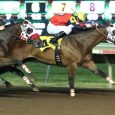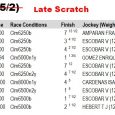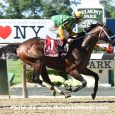 Few things in life are as full of magical promise as a young thoroughbred. Healthy colts are so full of the joy of life that they seem to be bursting out of their hides. It can be hard to believe that such vibrant animals may not be ready to race. Although thoroughbreds with predominantly American pedigrees were bred to mature earlier than most breeds (as noted in Peter Churchill’s book “The World Atlas of Horses and Ponies”), not all colts are ready to race at two or even three years old. Colts must be physically and mentally fit before their owners can even dream of future track triumphs.
Few things in life are as full of magical promise as a young thoroughbred. Healthy colts are so full of the joy of life that they seem to be bursting out of their hides. It can be hard to believe that such vibrant animals may not be ready to race. Although thoroughbreds with predominantly American pedigrees were bred to mature earlier than most breeds (as noted in Peter Churchill’s book “The World Atlas of Horses and Ponies”), not all colts are ready to race at two or even three years old. Colts must be physically and mentally fit before their owners can even dream of future track triumphs.
Physical Maturity
Despite their beauty and size, thoroughbreds are fragile and unnatural horses compared to feral horses like mustangs or older breeds like the Arabian. What the thoroughbred has gained in speed has come at the cost of bone strength. The University of Georgia notes that horses with long backs, such as thoroughbreds, are prone to future chronic back problems, because longer backs suffer from weak muscles compared to horses with short backs, such as draft horses.
Colts need to be strong enough not only to endure the pounding on their muscles and skeletons during a race, but to carry a load of over 100 pounds, consisting of the jockey, tack and any additional weight the handicapper orders it to carry. Good signs that a colt is healthy enough to race include:
- No change or increase in appetite during training and after a move from barn to barn or track to track. Horses off their feed cannot run their best.
- No significant weight loss during training unless the colt was overweight to begin with. Sudden weight loss is often a symptom of a underlying issues.
- No heat or swellings after workouts or breezes in any part of the body, especially the legs.
- No worms or worm eggs present in a fecal examination. Kentucky veterinarian and author Brent Kelley, DVM, writes that a fecal exam should be arranged while the colt is still in quarantine before mixing with the other horses in the stable.
Mental Maturity
One of the best American thoroughbreds of recent decades was Nashua (Nearco – Segulo, by Johnstown). He was fast and stayed relatively healthy during his racing career, yet was as unpredictable on the track as a bronco. He should have been a rarely defeated Triple Crown Champion. However, he only ran well when he felt like it. He was immature throughout his racing career. He lacked mental maturity.
The best racehorses are calm before races and can even relax during the race itself. Such a horse was Australia’s unbeaten champion sprinter Black Caviar. She was intelligent enough to eat when being hauled on trucks or airplanes. She could relax during a race, so she could save her tremendous powerful sprint until she was asked for it by her jockey.
Money Isn’t Everything
There is a good reason why horse racing is called the Sport of Kings — it takes being rich as a king to afford a stable full of thoroughbreds! It is tempting to try and get a return on your investment of the colt’s purchase price, vet fees, farrier fees and training costs as soon as your colt turns two. In the long run, though, it is better to be patient than to send an immature thoroughbred to race too soon.
Thoroughbreds look mature at two or three years old; however, they do not fully mature skeletally until they are four. All bones have openings, or growth plates. These do not close completely until a horse is about four… unless the horse is 17 hands or more. A very tall thoroughbred colt will not have a mature skeleton until he is about eight years of age.



